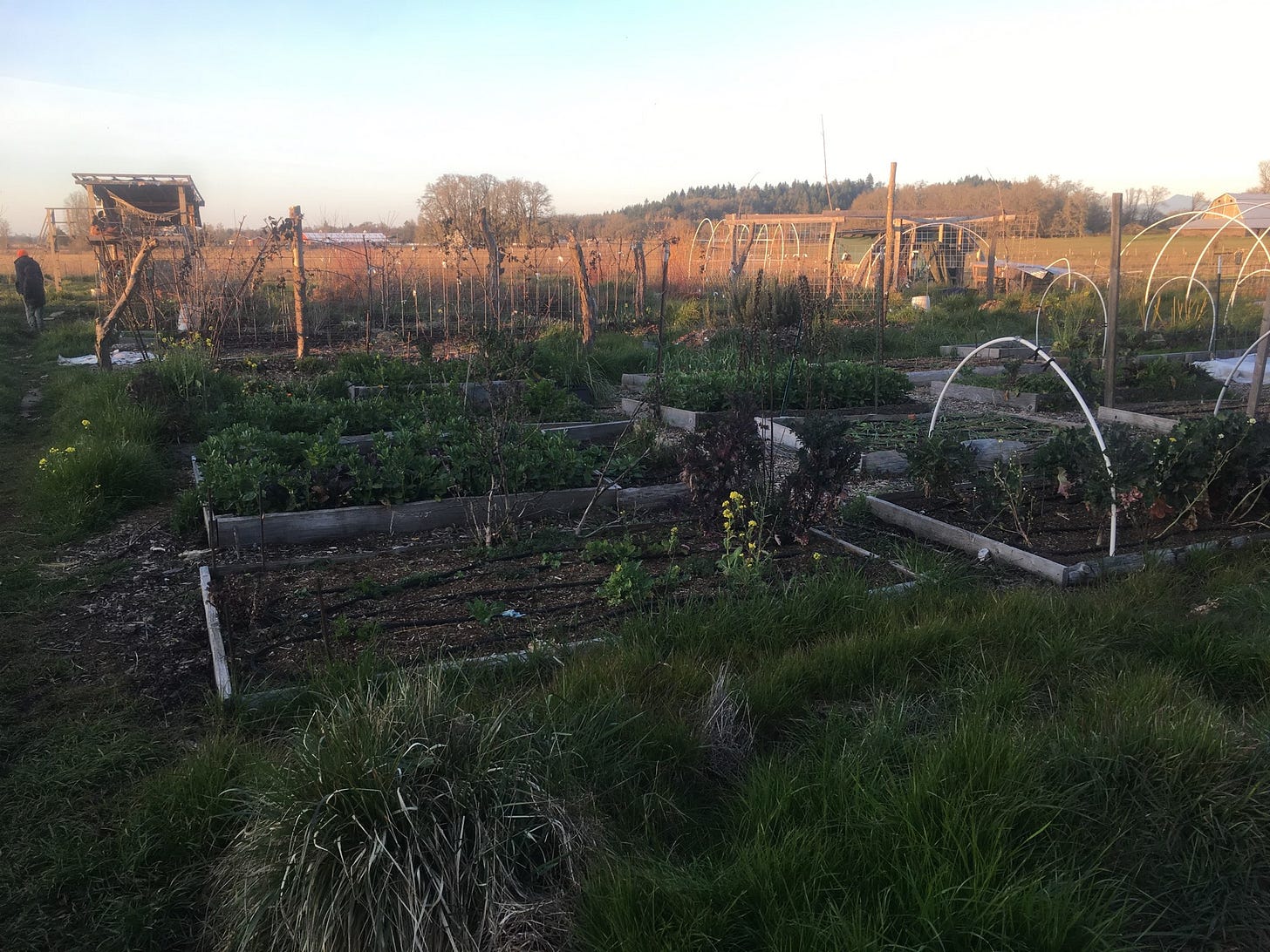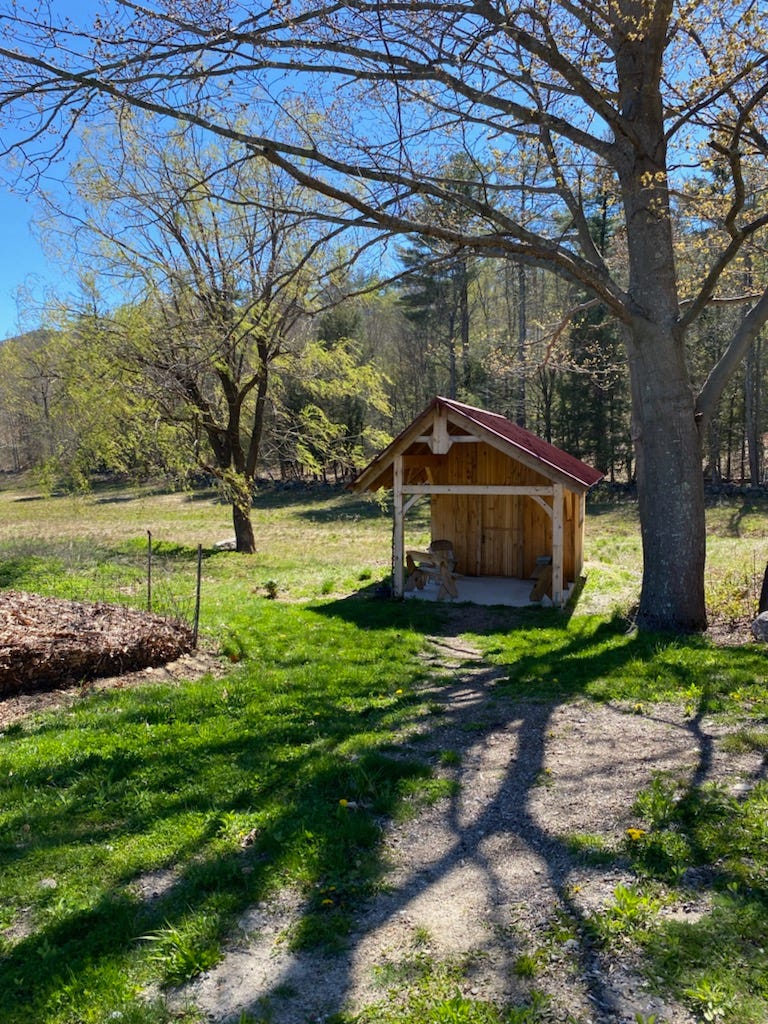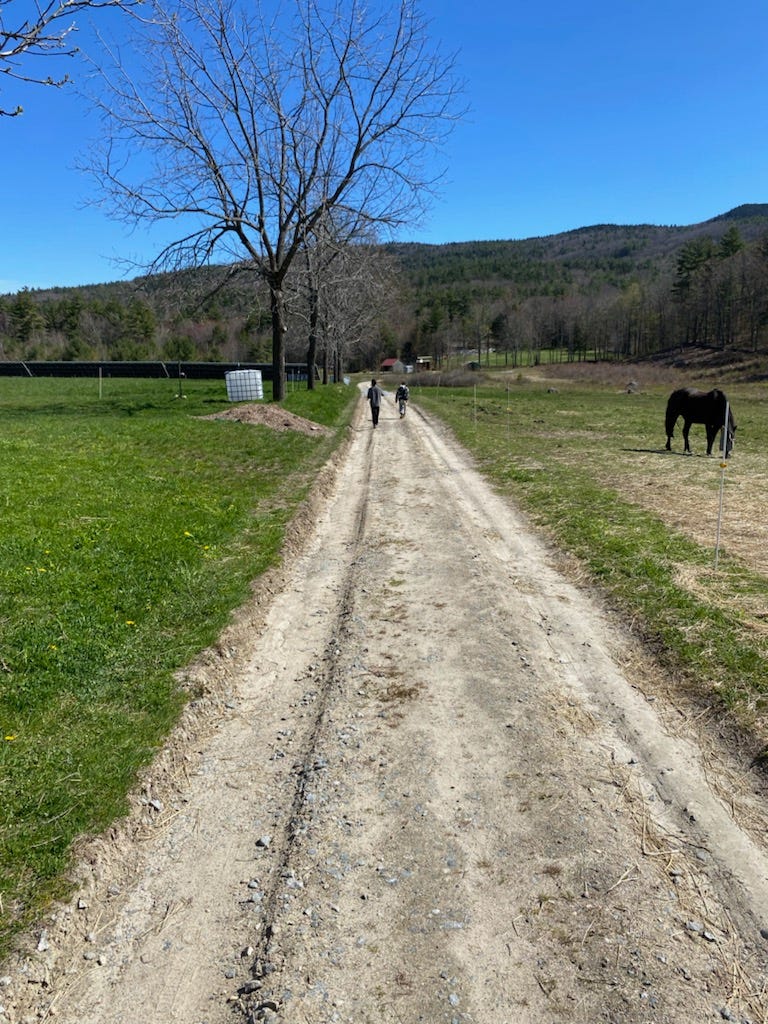Cooperative Farming and A Tale of Two Intentional Communities
Surprise, communities are not just for hippies!...Or maybe they are, and I'm just a hippie.
There have been times, while we have been travelling, where I have wondered if farming at the same property for so long has made me a terrible nomad. As a farmer, you build a connection with the land of your farm, so that your own metaphysical roots curl deep inside its dark crumbles, down deep inside where it is cool and dark and you don’t want to move. Likewise, prairie plants’ roots will grow into soil six feet down or more. Roots are the anchors fighting against soil erosion, but also, for these plants, it is just easier to stay put. Where their roots are is their home, and they clearly don’t want to leave.
Staying somewhere multiple years, the farmer’s roots grow deeper, too, like a perennial prairie plant. The tiny hair-like root radicles of the farmer’s roots grab onto what the bigger tendrils cannot, clinging to tiny specks or little limestone particles, the farmer’s knowledge deepening about everything that is possible to know about growing on the land; the areas that flood, the really fertile spots, the areas where the soil is too tight and anaerobic, and the ones where it is as loose and crumbly as cake. As time passes, a farmer’s land will entwine with the farmer in an almost spiritual way; there is immense responsibility in tending something so wonderous like soil, so full of life that science doesn’t even know the half of it. It contains organisms that humans can’t even yet fathom, humbling us as farmers and as people.
Having to leave our farm in Illinois made us never want to rent again. All I could think of is that if we had had more autonomy over our lives, we would never have had to leave. (We did, in fact, ask if we could buy Casey farm, but were turned down. It was crushing for us, since we felt buying the property would have solved everything, allowing us to be there long-term without worrying, and would have allowed us more control over our lives and our business.)
Leaving the farm, our goal was to penny-pinch and find something to buy. (Spoiler alert: the pandemic hits a few months into us travelling and farming, spiking all housing and land prices, and gobbling up any hopes of buying anything.) When it became evident that buying was going to be unaffordable for us, one thing did loom in the back of my mind that I dusted off: the thought of living in an intentional community.
Intentional communities vary, from hippie communes all living in one house, to more of stand-alone houses, where people do things communally, like meetings, potlucks, or cooking and food growing. I had been interested in them for a while, in a sustainability sense, but also in the sense of growing food collaboratively; when we had our milking goats, I always dreamed that one day, if we did milking or meat animals again, we could perhaps do it cooperatively. So when we were looking for a WWOOF farm job in Oregon, just before the pandemic hit, I stumbled upon an ad that said all that I wanted: milking animals, on-farm butchering, climate resilient farming, growing enough food in order to feed the people in its intentional community, and welcomes children. I requested our visit right away.
Arriving at the intentional community in a town near Eugene, Oregon, was slightly jarring. It looked like a beautiful, apocalyptical junkyard. There were only a few houses that were shabby but working, along with a converted city bus, a couple of yurts, and a couple of RVs. A hap-hazard patchwork quilt of sorts, things fitted in where they could go. Abandoned projects abounded, loose steel and a few dilapidated structures, all while dots and dabs of lush forest and mountain flowers peeked out in spots around the farm. The fruit and vegetable crops were in a bunch of small raised beds. It was a rainy Pacific Northwestern March when we arrived, and not a ton of food was growing yet. There were also animals, both outdoors and in the barn: goats, ducks, rabbits. The place was messy and a bit chaotic for sure, and I instantly fell in love with it.
We parked next to a shed, in a corner of the land, alongside a hill with thick-trunked trees. The first night we were there, we were invited to a meeting that this community had every week. The meetings, we would find, seemed to be part-therapy, part logistics. Though this community had its colorful characters and intense personalities, it was an amazingly well-functioning place.
The woman who I had been conversing with on email, Mary, was in charge of the food production at the farm, which all community members helped out with. For our job here, I hoped I would be able to participate in some of the on-farm butchering. On our last farm, it was written in our lease that we were not allowed to raise animals and slaughter them on the farm. It was a gut-punch to have that in our agreement, since I had wanted to do on-farm butchering since we had started our business. It was very important to me, as a holistic farmer, to be able to raise an animal outdoors and, instead of traumatizing it with a three-hour truck ride to a slaughterhouse (not to mention the fossil fuel usage), be able to kill it on the farm, swiftly, with minimal disturbance to its otherwise happy life. On-farm butchering was something I really wanted in our next chapter, whether we bought a farm or just lived on one as workers. Mary also really believed in it, too, and was an excellent butcher. One morning, when we decided I would be taking the WWOOF duties and Alex would do the homeschooling, Mary knocked at our RV door. “Hey,” she said to me, leaning in, “want to help me butcher a goat today?”
I had not butchered a goat since my first job World Hunger Relief farm. I was rusty, and I had hoped we would start with the smaller livestock, like ducks or rabbits, which I would help out with later, or something I was more familiar with, like chickens, but I sucked it up. I put on my raincoat and followed her into the barn.
The goat, whose name was Billy (killing a goat with a name: not my favorite thing!) was led out by Mary’s husband, Carl. Mary had a large knife, and told me, “I usually sing a prayer first, then I will do the killing, then we can both dress it.”
Carl held Billy down as he ma’ed. Mary sang a high-pitched song about every drop of blood returning to the earth, and at the second verse, used the knife to Billy’s throat. The ma’ing erupted several octaves higher and louder, and then it was quiet. Billy’s body shook under Carl’s weight, as Mary held down his front. The shaking seemed to last forever, but was more likely just a minute or two. I stood quietly in my raincoat as water drizzled through the barn roof, and felt a familiar tension, my muscles and eyes tight. Finally it was done.
Even though I believe immensely in raising animals holistically and butchering them as close as to where they lived as possible, killing animals is always a somber event. It is never fun to take a life, and to make it through, all you can really think of is how many people you can feed and what nourishment it can provide people around you. Carl strung Billy’s decapitated body on a barn beam, letting the blood drip onto the straw-covered floor. Mary and I both went to work with smaller knives, quietly piercing the skin, starting with just below the hoof, and peeling it away like a banana (if a banana was hard to peel). The body was warm and wet, and we threw away parts we didn’t want in a compost bucket, like the pale, slippery rope of the intestines, and in a different bucket, we kept the precious organs, like the liver and the heart. “We can make the liver right away for us,” Mary said. “I feel like the butchers should always get the liver, just because butchering is hard work and they really deserve that extra nourishment.”
After we talked about raising animals, and what different animals their community had raised over the years, which were all killed on-farm (including cows, where they had hired two guys to come in and do, taking them 45 minutes per cow, from slaughter to butchering, which to me sounded unbelievably fast), we were finally done. We had cut the different parts up and sealed them in freezer bags for the chest freezer. My hands, out of shape, were tired from the rigorous cutting through muscle and bone. “Come inside and I’ll cook up this liver,” Mary said, bringing the bucket with her.
After I had fitted all of the freezer bags away in their icy home, I shut the chest freezer door and went into Mary’s small house, one of the five houses on the properties. Her house was messy in a way the whole community’s property was messy, but also farm-messy: plenty of canned goods on the shelves, bulk things like beans and rice in jars, old yogurt containers containing dried herbs or frozen with pesto made in the summer. It had old rugs and carpet, and had a woodstove that flickered its orange light in the dim kitchen. It looked just like the woodstove we used to have.
Working and visiting so many farms, I had a hard time for a while not being jealous. I had serious house-envy looking around; I wished this was my house, my kitchen, my woodstove. I wished I could have as many kitchen projects as she had going. I wished I could be making elecampangle syrup that I helped her make later that day, digging up the elecampange’s muddy roots, washing the thick clay from its tangles and cooking it in a metal pot on low and then bottling it up for a lung emergency. Instead, I thought painfully of the elecampange I had planted at our farm, and how I had to leave it before ever harvesting it, its huge pale leaves seemingly waving goodbye.
Alas, I snapped out it, abruptly, like a mousetrap in the mind. I returned my focus to the liver cooking in butter in her black cast-iron pan. Mary then put something else in to sizzle in the butter. “Ever eat goat testicles before?” She said, adding salt.
“Hm, no,” I said, thankful Alex was not here to get grossed out. I am definitely the more adventurous eater, while Alex remains the most picky eater in our family. (In some families that job goes to the children, but thankfully, not our children, who take after me and will eat anything.) Mary served me some of the liver and testicle on a small plate. I ate the testicle first; it tasted like pure, succulent fat, seemingly melting to pale liquid in my mouth. Mary smiled, chewing. “Good, right?” she said, as I enthusiastically nodded, my mouth still full.
Though Mary brainstormed with me how we could stay permanently in the community, helping us to find jobs (tricky at this time, since the pandemic had started and the world was shutting down), we ultimately decided that Oregon was perhaps too far for us, and also, there was no available house in the community; we would have had to stay in the RV bus indefinitely. Though community, as it turned out, was something I realized I badly wanted, some kind of living space that was bigger than 250 square feet was also just as important of a goal.
The intentional community in New Hampshire was a little different, as it really was about, as was continually stated to me, “expanding your family”. Though at first I was alarmed at the way that sounded, it turned out to feel a lot more normal than I thought it would.
At Plowshare farm, everyone in the community works together and eats together. Everyone lives in one of the shared homes together, and after about a week, it surprisingly started to feel very natural. Every morning before everyone started working their various jobs on the farm, everyone would have breakfast together at one large table, which was the same every morning: steaming bowls of oatmeal with honey and milk, milked from the cows outside. Lunch was eaten all together in the communal building. I was lucky enough to sit next to one of the main lunch cooks one day, and grilled him to find out what he had to work with every day to feed all fifty people who lived there. Lunch was the same formula, he said; some kind of soup, a sourdough bread (that they baked in their bakery upstairs), and salad (this month it was from the hoophouses, a spinach and an overwintered spicy greens mix). The cook, whose name was Nate, told me it was usually beans, chickpeas of lentils in the soup, with whatever vegetables they had, plus spices and bone broth, made from the bones of the steers on the farm. Dinner was different and cooked by different people in different houses; in our house, we had things from mac and cheese and salad to beans in tomato sauce with spinach. Things that were made were very simple with few ingredients, and they were all about eliminating waste and using what was available.
The biggest aspect of Plowshare farm, besides all of the food growing, was what they call “life-sharing”. People of different cognitive diversities and disabilities live at Plowshare. Some people need more care than others. We worked alongside people of all kinds, whether it was weeding in the garden or shoveling manure, or making sheets of wool from their sheep. Our days there were very full, but really rewarding, and always felt supported. It was, like the community in Oregon, a place where I never felt our family could be lonely, and, like Oregon, a big part of me wanted to stay forever.
A farmer’s roots can tunnel deep into the land, but that can also be a lonely path. Maybe the land doesn’t have to be just that farmer’s; maybe it can also be shared with others that share the same values, the same love for the land, the same pure desire to help and feed people, unburdened by greed, just a simple need to do things that are worthwhile. Maybe, I believe now, a farmer doesn’t have to own land necessarily, but just have a situation where they are able to age in place, grow old with the trees, with wisdom deepening and everyone forming wheat-colored rings inside as the years go by. I am hoping to grow with a place of our own, but “own” doesn’t have to look like what I initially thought; rather, it can be a lot more colorful.
On the Road:
Oh my gosh, we have been on the road all right! We went to Virginia to visit family, then worked our job and scouted out New Hampshire as a possible future living situation, then popped over to New Jersey for a family memorial, and now we are in Ithaca, New York, visiting another—you guessed it—intentional community. Apparently, they are my new obsession, along with looking at youtube videos about sewing in order to learn about a sewing machine handed down to me by my mother-in-law. We are leaving in a few days, back to Illinois, hopefully to sell a couple more pieces of equipment (almost done! Jk not really at all). We are sussing out a few things after that, and then we can stop travelling for a while (fingers and toes crossed).
From the Tiny Kitchen:
Cooking has been….not really getting done, lately. In New Hampshire, every meal was cooked for us, which made me feel all out of sorts. Though it was very nice to get a break, I realized how I do like to anchor my days by making dinner. Anyway, I am back to cooking, but I really need to get back on my game!









Beautifully written. As much as I enjoy reading your adventures, I hope even more that your writing is cathartic and healing to your own self.
Thank you for this post, Alison. I have learned of the farmer's bond with her land. I have learned that goat testicles are deliciously fatty. That alone makes me feel bold enough to try one or even two! And your own continuing journey toward a home. I remember your farm in Illinois. It was so beautiful. I hope something even better awaits you and yours. Please get together with the Carrolls and the Lyonses when y'all are back in Illinois.